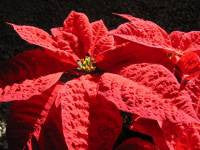
In the Northern Hemisphere, poinsettias are now available in plant nurseries. These plants have become a part of winter holiday traditions, so it is likely that children will see them. When poinsettias appear in classrooms, you have an opportunity to introduce children to the euphorbia family and its unusual flowers.
Don’t worry about these attractive plants being poisonous. That myth has been debunked. The sap of this plant, like other members of the euphorbia family, is irritating to skin and eyes, but the plant is no great hazard in the classroom. They are no more than a mild irritant to cats and dogs. People that have an allergy to natural latex rubber could have an allergic reaction to the sap, as natural rubber comes from another member of the euphorbia family, the rubber tree, Hevea brasiliensis.
I have written a booklet for children that shows how poinsettias are grown and gives the botanical details of their bracts and flowers. It is available as a print-it-yourself file on the Big Picture Science website. I took the photos a few years ago at a small greenhouse near Conifer, Colorado. In order to trigger the plants to form flowers, they must have a dark period at night. Even a little light exposure will stop the production of buds. The greenhouse I visited was well away from the pollution of city lights.
The length of the darkness increases as days become shorter in the fall, and that is what triggers poinsettias to flower. In their native climate in Mexico and Central America, the length of darkness is only about 13 hours maximum, so flowering doesn’t require a long period of darkness. The darkness needs to be complete, however.
The brightly colored bracts are modified leaves. The flowers are in the yellow, cup-like structures in the center of the bracts. They have no petals, and children will be able to see the flowers’ details more clearly with a magnifying glass. My booklet, The Story of Poinsettias at TaTonka Farms, will help you figure out the puzzle of the flowers' structure.
 Now you can purchase a file for printing 13 posters that illustrate the levels of life’s structural organization. The levels are the biosphere, biomes, ecosystems, biological communities, populations, individual organisms, organ systems, organs and tissues, cells, organelles, macromolecules, small building block molecules, and atoms.
Now you can purchase a file for printing 13 posters that illustrate the levels of life’s structural organization. The levels are the biosphere, biomes, ecosystems, biological communities, populations, individual organisms, organ systems, organs and tissues, cells, organelles, macromolecules, small building block molecules, and atoms.
This framework is an important part of life science literacy that is seldom shown all at once, and children will benefit from seeing it. My book, From the Biosphere to Atoms: A Teacher’s Guide to the Organization of the Living World, has basic concepts and lessons that go with each level of organization. It is available both as a printed book and as an “e-book,” a PDF file of the book that you can view on your computer or print for yourself.
You may notice a few changes on the new PDF of the posters. The talented artist who colored the posters made the mitochondria green, and it would have been difficult to have her redo that color at the time the originals were colored. Recently I figured out how to use Photoshop to overlay a different color, so now the mitochondria are orange-toned, better in my opinion for an organelle that deals in energy and less likely to be confused with chloroplasts.
We have a few of the printed posters still available, but instead of reprinting it, I decided to make the file available for schools to print their own. When a poster gets something spilled on it, gets torn or damaged, or just wears out, you can reprint it for your classroom. You can print the file at full scale on 11” X 14” cardstock or shrink it to a smaller size. The text is large enough to read when the posters are printed on 8.5” X 11” (letter-sized) paper. Please note that the copyright gives you permission to print the file for your classroom and for two more classrooms in the same school. Please ask others to purchase their own file for printing and please do not share the file.
Do you use these posters? How do children react to them? I would enjoy hearing about your experiences with this material.
A note to international buyers: These posters show North American biomes, ecosystem, and biological community. The organisms are a Ponderosa pine tree and a native squirrel. You may wish to add illustrations of your local ecosystem and organisms. The organ is a trachea from the respiratory system of the squirrel, but is similar in appearance to that of most mammals. The tissues, cells, molecules, and atoms posters are useful anywhere. Montessori Downunder in New Zealand has a black and white set of these posters that show the biosphere centered on the Southern Hemisphere and native New Zealand marine mammals.
Priscilla Spears


 Now you can purchase a file for printing 13 posters that illustrate the levels of life’s structural organization. The levels are the biosphere, biomes, ecosystems, biological communities, populations, individual organisms, organ systems, organs and tissues, cells, organelles, macromolecules, small building block molecules, and atoms.
Now you can purchase a file for printing 13 posters that illustrate the levels of life’s structural organization. The levels are the biosphere, biomes, ecosystems, biological communities, populations, individual organisms, organ systems, organs and tissues, cells, organelles, macromolecules, small building block molecules, and atoms.